Glossary
Plant Care Library
N
Nematanthus Gregarius
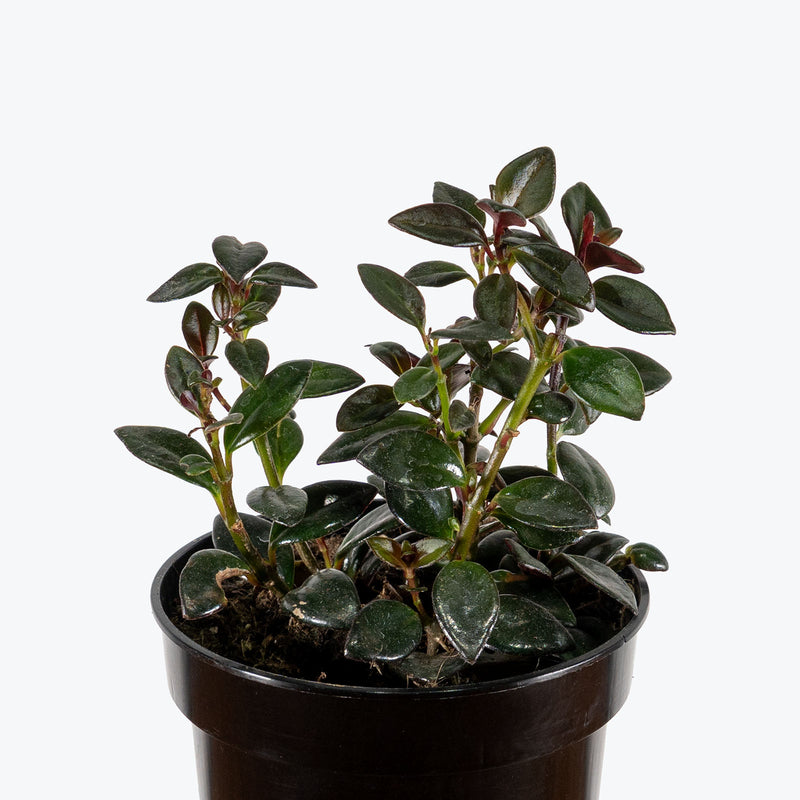
How to care for Nematanthus Gregarius
Nematanthus Gregarius should not be in a position to see the sun directly, although early morning or late evening sun is fine. Filtered sunlight through a sheer curtain is best and most homes are comprised primarily of indirect sunlight. The best spot for them is where they do not see the sun during the majority of the day but still get bright, indirect light.
Nematanthus Gregarius will thrive in bright light, but also can tolerate medium light. A good medium-light place in your home would be in the middle of a room that has a regular size window. They can be placed anywhere between the middle of the room and the window. Remember that plants will grow based on how much light they receive.
Nematanthus Gregarius needs to be watered when the top half of the soil is dry to the touch. That usually takes about 1 week in an average home environment. It will vary depending on the time of year, your environment and lighting conditions, but it's always safer to underwater or give the soil a check before you water again. Expect to water more often in brighter light and less often in lower light.
Nematanthus Gregarius will do well in average humidity environments but will appreciate a little bit of humidity if provided, give them a mist daily or get a humidifier.
Avoid getting cold water on the foliage, as this can burn the leaves! If you want your Nematanthus Gregarius to keep on blooming, keep it in a location that receives bright, indirect light rather than medium light. They prefer to be slightly pot-bound, which will also encourage more blooms. Fertilize weekly during the growing season with diluted liquid fertilizer. Prune back the stems after flowering to encourage bushier growth and more blooms in the following season. Regularly clean the leaves with a damp cloth to remove dust and boost photosynthesis.
You can feel comfortable having Nematanthus Gregarius around your home in the potential case where your pet feels like nibbling on it. However, we typically recommend keeping your pets from eating any of your houseplants..
View PlantNematanthus Marlene
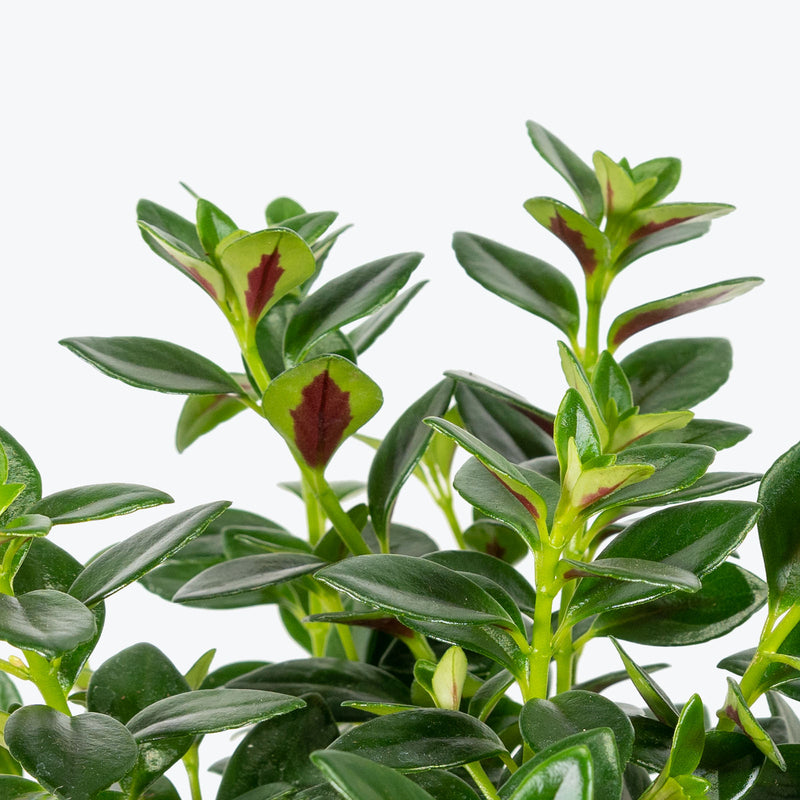
How to care for Nematanthus Marlene
Nematanthus Marlene should not be in a position to see the sun directly, although early morning or late evening sun is fine. Filtered sunlight through a sheer curtain is best and most homes are comprised primarily of indirect sunlight. The best spot for them is where they do not see the sun during the majority of the day but still get bright, indirect light.
Nematanthus Marlene will do best in bright light. A nice bright place inside your home would be on the window sill or a stool that is right next to a window, either with or without blinds, depending on if the plant can handle sun. Remember that plants will grow based on how much light they receive.
Nematanthus Marlene needs to be watered when the top half of the soil is dry to the touch. That usually takes about 1 week in an average home environment. It will vary depending on the time of year, your environment and lighting conditions, but it's always safer to underwater or give the soil a check before you water again. Expect to water more often in brighter light and less often in lower light.
Nematanthus Marlene can live in any average home humidity condition and are fairly hardy.
To encourage frequent flowering, place Nematanthus Marlene in bright, indirect light and prune lightly after each bloom cycle. A well-draining, slightly acidic soil mix will keep roots healthy. Avoid letting it sit in soggy soil. Fertilize every 4–6 weeks in spring and summer with a bloom-boosting formula. Clean the glossy leaves gently to show off their bicolour beauty. Perfect for hanging baskets, 'Marlene' appreciates room to trail and will reward you with continuous, cheerful blooms under the right care.
You can feel comfortable having Nematanthus Marlene around your home in the potential case where your pet feels like nibbling on it. However, we typically recommend keeping your pets from eating any of your houseplants..
View PlantNematanthus Variegated Goldfish Plant
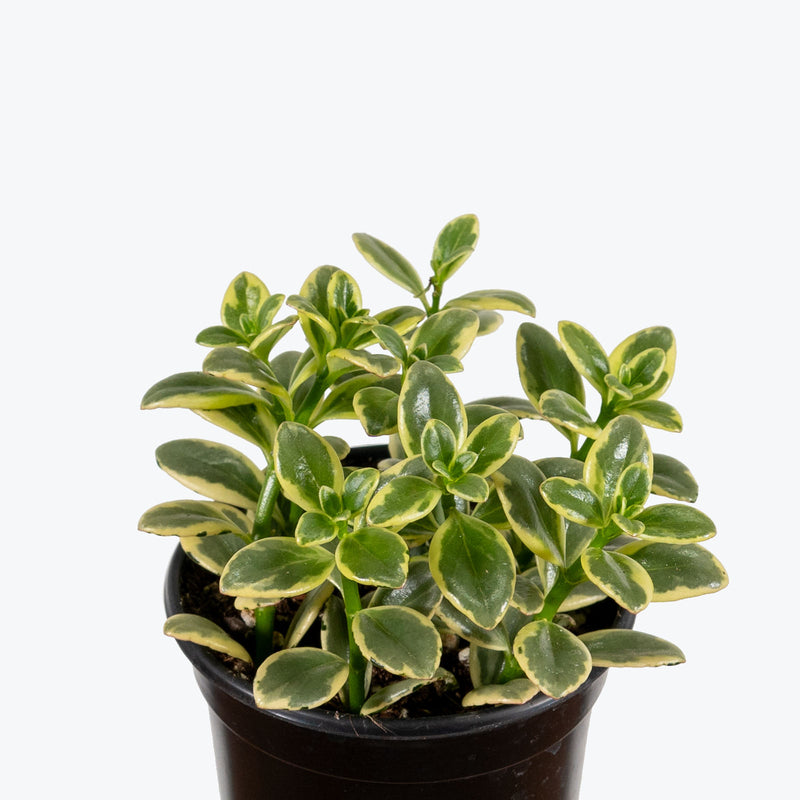
How to care for Nematanthus Variegated Goldfish Plant
They should not be in a position to see the sun directly, although early morning or late evening sun is fine. Filtered sunlight through a sheer curtain is best and most homes are comprised primarily of indirect sunlight. The best spot for them is where they do not see the sun during the majority of the day but still get bright, indirect light.
They will do best in bright light. A nice bright place inside your home would be on the window sill or a stool that is right next to a window, either with or without blinds, depending on if the plant can handle sun. Remember that plants will grow based on how much light they receive.
They need to be watered when the top half of the soil is dry to the touch. That usually takes about 1 week in an average home environment. It will vary depending on the time of year, your environment and lighting conditions, but it's always safer to underwater or give the soil a check before you water again. Expect to water more often in brighter light and less often in lower light.
They will do well in average humidity environments but will appreciate a little bit of humidity if provided, give them a mist daily or get a humidifier.
The Goldfish Plant's colour intensity and growth shape are highly dependent on the light it receives, with bright, filtered, or dappled sunlight allowing it to perform essential functions without burning its leaves or dehydrating the plant.
You can feel comfortable having this plant around your home in the potential case where your pet feels like nibbling on it. However, we typically recommend keeping your pets from eating any of your houseplants..
View PlantNepenthes Diana
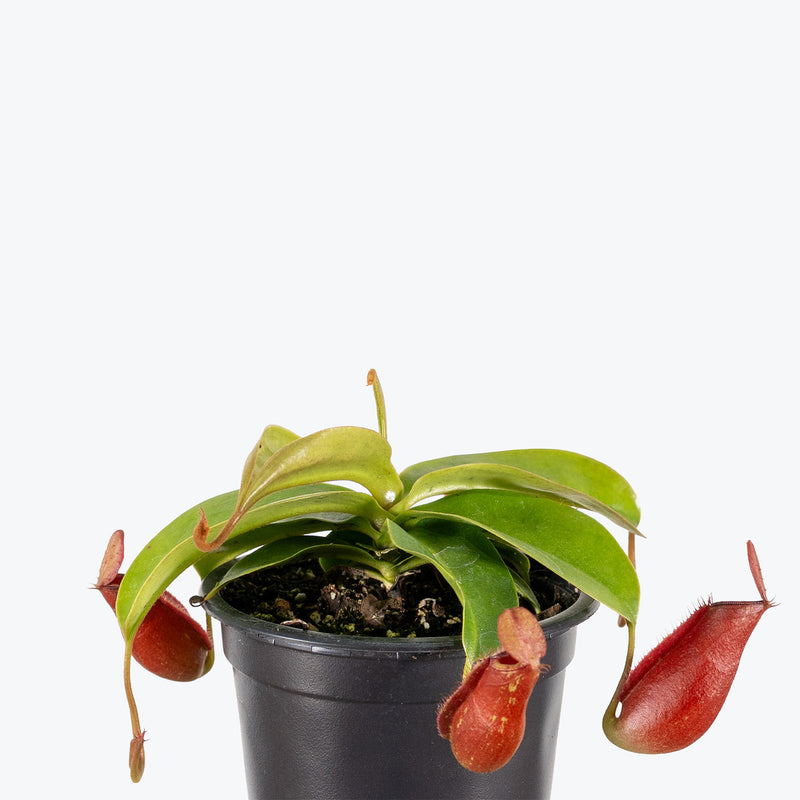
How to care for Nepenthes Diana
Nepenthes Diana enjoys some direct sun, but they'll also do well in bright, indirect light. It is best to place this plant somewhere where it will receive some nice morning sun, or a couple hours of afternoon sun, and then indirect light for the rest of the day.
Nepenthes Diana will thrive in bright light, but also can tolerate medium light. A good medium-light place in your home would be in the middle of a room that has a regular size window. They can be placed anywhere between the middle of the room and the window. Remember that plants will grow based on how much light they receive.
Allow the top quarter of the soil to dry before watering Nepenthes Diana again. This usually takes about 3 - 4 days in an average home environment. It will vary depending on the time of year, your environment and lighting conditions. Expect to water more often in brighter light and less often in lower light.
Nepenthes Diana will do well in average humidity environments but will appreciate a little bit of humidity if provided, give them a mist daily or get a humidifier.
Use a well-draining carnivorous plant mix, such as sphagnum moss and perlite or orchid bark, and avoid any fertilizers in the soil. Feed occasionally with small insects or dilute foliar feed every few weeks in the growing season. Provide good airflow and stable warmth; Nepenthes Diana grows equally well in terrariums, greenhouses, or bright windowsills.
Nepenthes Diana is moderately toxic and can cause some adverse reactions when ingested so it is best to not let your pets eat it, which we advise for all plants in general. The severity of the reaction will depend on how much of the plant is ingested but, if you know your pet typically does not eat your plants, this plant will be suitable for your home..
View PlantNepenthes Dyeriana
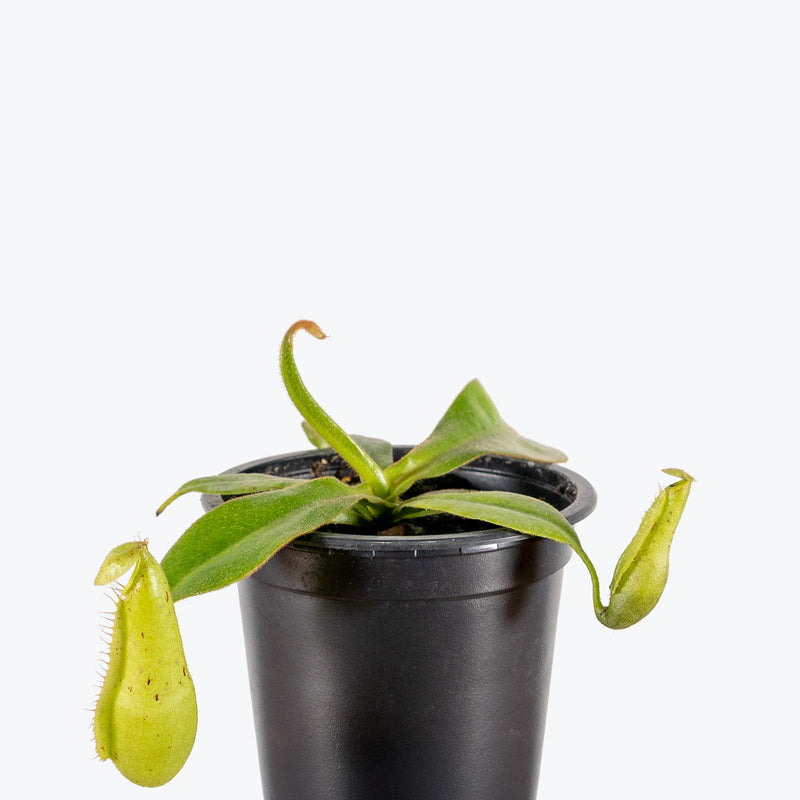
How to care for Nepenthes Dyeriana
Nepenthes Dyeriana should not be in a position to see the sun directly, although early morning or late evening sun is fine. Filtered sunlight through a sheer curtain is best and most homes are comprised primarily of indirect sunlight. The best spot for them is where they do not see the sun during the majority of the day but still get bright, indirect light.
Nepenthes Dyeriana will do best in bright light. A nice bright place inside your home would be on the window sill or a stool that is right next to a window, either with or without blinds, depending on if the plant can handle sun. Remember that plants will grow based on how much light they receive.
Allow the top quarter of the soil to dry before watering Nepenthes Dyeriana again. This usually takes about 3 - 4 days in an average home environment. It will vary depending on the time of year, your environment and lighting conditions. Expect to water more often in brighter light and less often in lower light.
Nepenthes Dyeriana likes a high humidity environment, give them a mist daily or as often as possible. Alternatively, you can put them around a humidifier. Although they won't die if they don't receive enough humidity, their leaves may have some dry, crunchy, or yellow edges.
Nepenthes Dyeriana thrives in warm, bright, and humid conditions. A hanging basket or shelf near a bright window is ideal. Avoid dry air and low light — both can stunt pitcher development. Feed monthly with diluted orchid fertilizer or by dropping small insects directly into the pitchers. Avoid fertilizing the soil. Use a well-draining, airy mix such as sphagnum moss with perlite or orchid bark. This hybrid handles temperature swings better than most Nepenthes, but keep it away from frost. Prune older vines to encourage bushier growth and new pitcher production.
Nepenthes Dyeriana is moderately toxic and can cause some adverse reactions when ingested so it is best to not let your pets eat it, which we advise for all plants in general. The severity of the reaction will depend on how much of the plant is ingested but, if you know your pet typically does not eat your plants, this plant will be suitable for your home..
View PlantNepenthes Mirabilis Var. Globosa
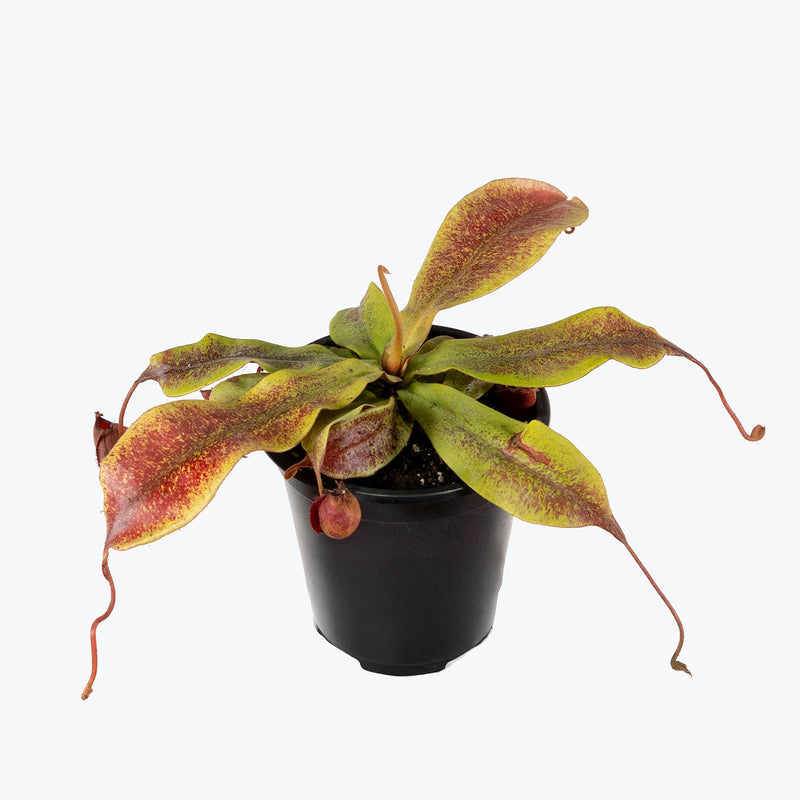
How to care for Nepenthes Mirabilis Var. Globosa
Nepenthes Mirabilis Var. Globosa should not be in a position to see the sun directly, although early morning or late evening sun is fine. Filtered sunlight through a sheer curtain is best and most homes are comprised primarily of indirect sunlight. The best spot for them is where they do not see the sun during the majority of the day but still get bright, indirect light.
Nepenthes Mirabilis Var. Globosa will do best in bright light. A nice bright place inside your home would be on the window sill or a stool that is right next to a window, either with or without blinds, depending on if the plant can handle sun. Remember that plants will grow based on how much light they receive.
Allow the top quarter of the soil to dry before watering Nepenthes Mirabilis Var. Globosa again. This usually takes about 3 - 4 days in an average home environment. It will vary depending on the time of year, your environment and lighting conditions. Expect to water more often in brighter light and less often in lower light.
Nepenthes Mirabilis Var. Globosa likes a high humidity environment, give them a mist daily or as often as possible. Alternatively, you can put them around a humidifier. Although they won't die if they don't receive enough humidity, their leaves may have some dry, crunchy, or yellow edges.
Grow Nepenthes mirabilis var. globosa in lowland or warm-intermediate conditions with high humidity and strong, filtered light. Use an airy, well-draining medium such as sphagnum moss mixed with perlite or orchid bark. Feed monthly with diluted orchid fertilizer into the pitchers, or drop in small insects. Keep temperatures consistently warm and avoid cold drafts. With the right care, this plant rewards you with bold, colourful traps and a truly unique silhouette.
Nepenthes Mirabilis Var. Globosa is moderately toxic and can cause some adverse reactions when ingested so it is best to not let your pets eat it, which we advise for all plants in general. The severity of the reaction will depend on how much of the plant is ingested but, if you know your pet typically does not eat your plants, this plant will be suitable for your home..
View PlantNepenthes Mirabilis Var. Globosa x Ampullaria Black Miracle
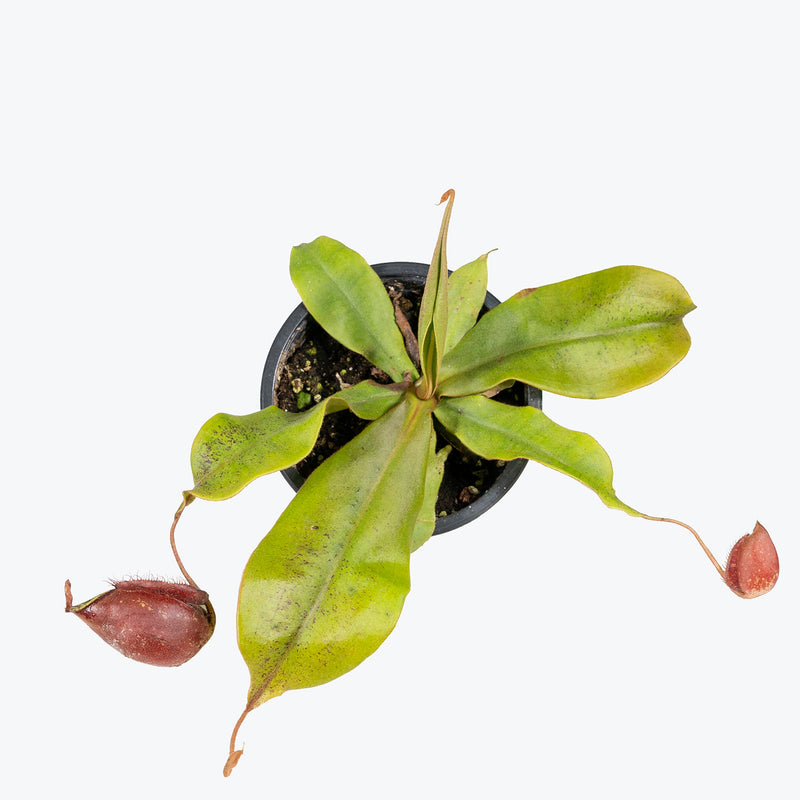
How to care for Nepenthes Mirabilis Var. Globosa x Ampullaria Black Miracle
Nepenthes mirabilis var. globosa × ampullaria 'Black Miracle' should not be in a position to see the sun directly, although early morning or late evening sun is fine. Filtered sunlight through a sheer curtain is best and most homes are comprised primarily of indirect sunlight. The best spot for them is where they do not see the sun during the majority of the day but still get bright, indirect light.
Nepenthes mirabilis var. globosa × ampullaria 'Black Miracle' will do best in bright light. A nice bright place inside your home would be on the window sill or a stool that is right next to a window, either with or without blinds, depending on if the plant can handle sun. Remember that plants will grow based on how much light they receive.
Allow the top quarter of the soil to dry before watering Nepenthes mirabilis var. globosa × ampullaria 'Black Miracle' again. This usually takes about 3 - 4 days in an average home environment. It will vary depending on the time of year, your environment and lighting conditions. Expect to water more often in brighter light and less often in lower light.
Nepenthes mirabilis var. globosa × ampullaria 'Black Miracle' likes a high humidity environment, give them a mist daily or as often as possible. Alternatively, you can put them around a humidifier. Although they won't die if they don't receive enough humidity, their leaves may have some dry, crunchy, or yellow edges.
Grow Nepenthes mirabilis var. globosa × ampullaria 'Black Miracle' in a well-draining, airy mix such as sphagnum moss with perlite or orchid bark. Maintain high humidity and avoid cold drafts or temperature drops. Feed the pitchers monthly with diluted orchid fertilizer or drop small insects directly into the pitchers — do not fertilize the soil. Rotate occasionally to ensure balanced growth. Given the bold foliage and colour variation, this plant does best in consistent lighting and warm, lowland conditions year-round.
Nepenthes mirabilis var. globosa × ampullaria 'Black Miracle' is moderately toxic and can cause some adverse reactions when ingested so it is best to not let your pets eat it, which we advise for all plants in general. The severity of the reaction will depend on how much of the plant is ingested but, if you know your pet typically does not eat your plants, this plant will be suitable for your home..
View PlantNepenthes Neon
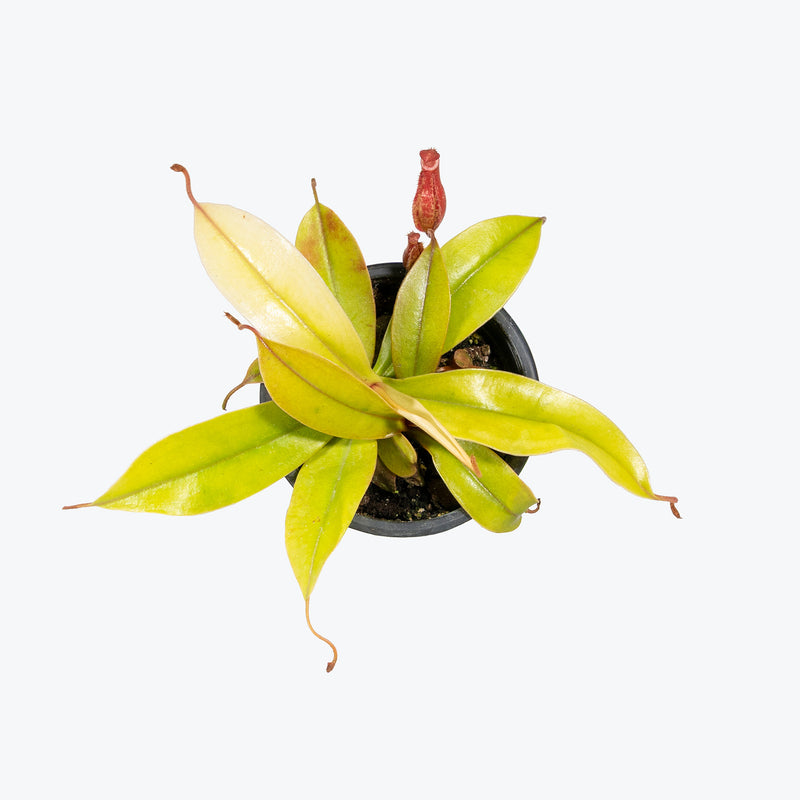
How to care for Nepenthes Neon
Nepenthes Neon should not be in a position to see the sun directly, although early morning or late evening sun is fine. Filtered sunlight through a sheer curtain is best and most homes are comprised primarily of indirect sunlight. The best spot for them is where they do not see the sun during the majority of the day but still get bright, indirect light.
Nepenthes Neon will do best in bright light. A nice bright place inside your home would be on the window sill or a stool that is right next to a window, either with or without blinds, depending on if the plant can handle sun. Remember that plants will grow based on how much light they receive.
Allow the top quarter of the soil to dry before watering Nepenthes Neon again. This usually takes about 3 - 4 days in an average home environment. It will vary depending on the time of year, your environment and lighting conditions. Expect to water more often in brighter light and less often in lower light.
Nepenthes Neon likes a high humidity environment, give them a mist daily or as often as possible. Alternatively, you can put them around a humidifier. Although they won't die if they don't receive enough humidity, their leaves may have some dry, crunchy, or yellow edges.
Nepenthes Neon adapts well to both lowland and intermediate conditions, making it a great choice for growers in varying climates. Plant in a well-draining medium such as sphagnum moss with perlite or orchid bark. Feed monthly with diluted orchid fertilizer or by dropping small insects into the pitchers. The bold colour contrast is strongest in bright, filtered light — rotate the pot occasionally to promote even growth. As a hybrid, it's naturally more forgiving, making it perfect for both seasoned growers and curious beginners.
Nepenthes Neon is moderately toxic and can cause some adverse reactions when ingested so it is best to not let your pets eat it, which we advise for all plants in general. The severity of the reaction will depend on how much of the plant is ingested but, if you know your pet typically does not eat your plants, this plant will be suitable for your home..
View PlantNepenthes Pitcher Plant
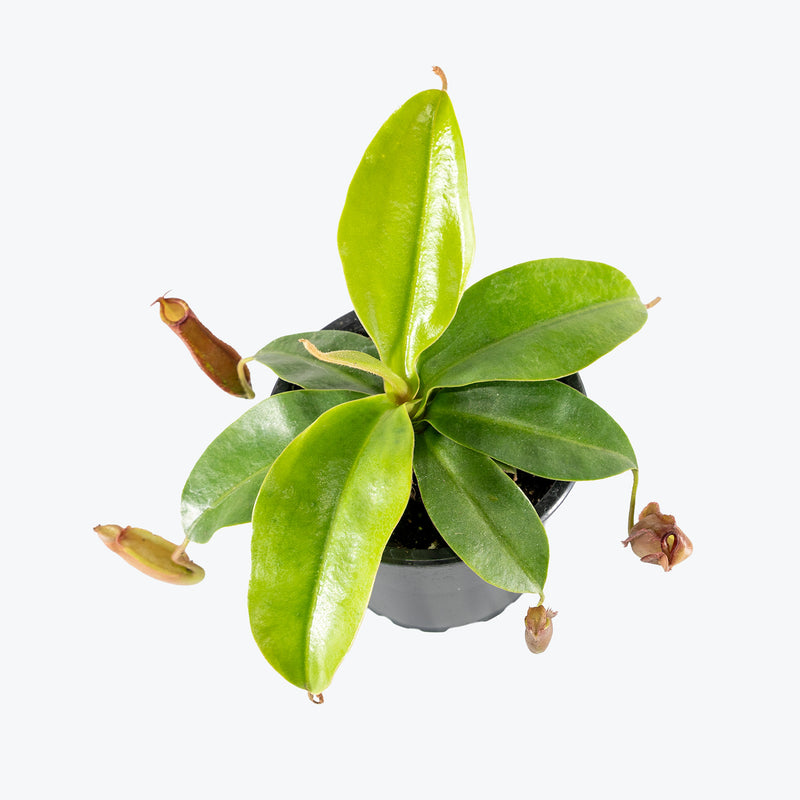
How to care for Nepenthes Pitcher Plant
Nepenthes Pitcher Plant should not be in a position to see the sun directly, although early morning or late evening sun is fine. Filtered sunlight through a sheer curtain is best and most homes are comprised primarily of indirect sunlight. The best spot for them is where they do not see the sun during the majority of the day but still get bright, indirect light.
Nepenthes Pitcher Plant will thrive in bright light, but also can tolerate medium light. A good medium-light place in your home would be in the middle of a room that has a regular size window. They can be placed anywhere between the middle of the room and the window. Remember that plants will grow based on how much light they receive.
Allow the top quarter of the soil to dry before watering Nepenthes Pitcher Plant again. This usually takes about 3 - 4 days in an average home environment. It will vary depending on the time of year, your environment and lighting conditions. Expect to water more often in brighter light and less often in lower light.
Nepenthes Pitcher Plant likes a high humidity environment, give them a mist daily or as often as possible. Alternatively, you can put them around a humidifier. Although they won't die if they don't receive enough humidity, their leaves may have some dry, crunchy, or yellow edges.
Nepenthes Pitcher Plant is sensitive to minerals and chemicals often found in tap water. It's best to water them with rainwater or distilled water to avoid potential issues. Keep the soil consistently moist but not waterlogged. Fertilization is generally not necessary, as Nepenthes obtain essential nutrients from their prey. However, if you wish to fertilize, use a very diluted fertilizer applied directly to the pitchers. Regularly trim any dead or dying pitchers to encourage new growth. Avoid touching or manually triggering the pitchers, as this can exhaust the plant.
Nepenthes Pitcher Plant is moderately toxic and can cause some adverse reactions when ingested so it is best to not let your pets eat it, which we advise for all plants in general. The severity of the reaction will depend on how much of the plant is ingested but, if you know your pet typically does not eat your plants, this plant will be suitable for your home..
View PlantNepenthes x Rebecca Soper
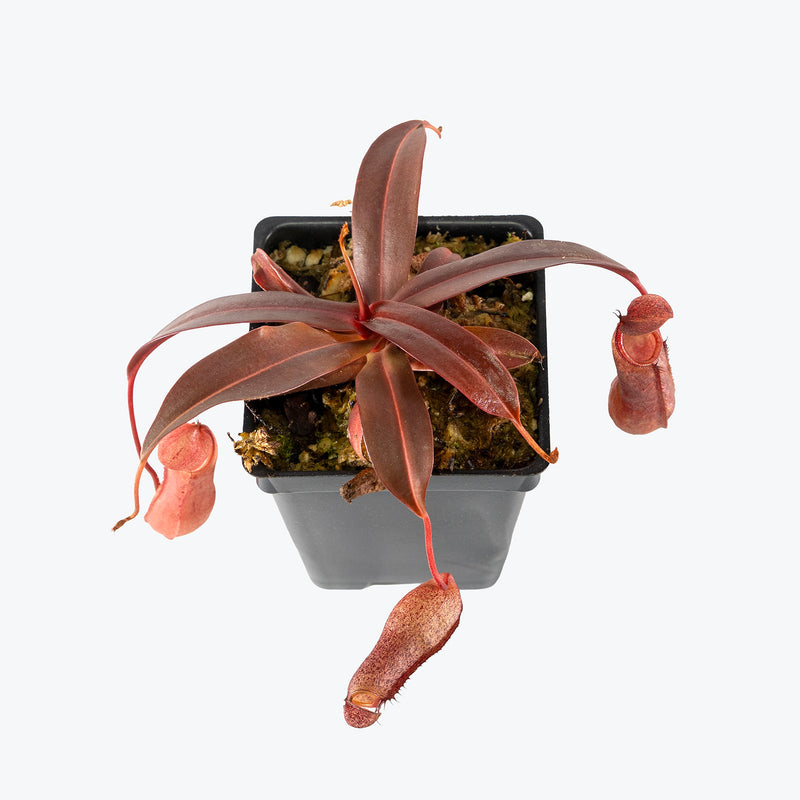
How to care for Nepenthes x Rebecca Soper
Nepenthes x Rebecca Soper should not be in a position to see the sun directly, although early morning or late evening sun is fine. Filtered sunlight through a sheer curtain is best and most homes are comprised primarily of indirect sunlight. The best spot for them is where they do not see the sun during the majority of the day but still get bright, indirect light.
Nepenthes x Rebecca Soper will thrive in bright light, but also can tolerate medium light. A good medium-light place in your home would be in the middle of a room that has a regular size window. They can be placed anywhere between the middle of the room and the window. Remember that plants will grow based on how much light they receive.
Allow the top quarter of the soil to dry before watering Nepenthes x Rebecca Soper again. This usually takes about 3 - 4 days in an average home environment. It will vary depending on the time of year, your environment and lighting conditions. Expect to water more often in brighter light and less often in lower light.
Nepenthes x Rebecca Soper will do well in average humidity environments but will appreciate a little bit of humidity if provided, give them a mist daily or get a humidifier.
Use a well-draining, airy carnivorous mix (such as sphagnum moss with perlite or orchid bark). Avoid fertilizers in the soil — instead, feed by placing a dried insect or very diluted fertilizer solution directly into the pitchers. Regularly trim old pitchers to direct energy into fresh growth. Nepenthes x Rebecca Soper is unusually tolerant of temperature swings, making it one of the most forgiving Nepenthes to grow.
Nepenthes x Rebecca Soper is moderately toxic and can cause some adverse reactions when ingested so it is best to not let your pets eat it, which we advise for all plants in general. The severity of the reaction will depend on how much of the plant is ingested but, if you know your pet typically does not eat your plants, this plant will be suitable for your home..
View PlantNorfolk Island Pine

How to care for Norfolk Island Pine
Norfolk Island Pine enjoys some direct sun, but they'll also do well in bright, indirect light. It is best to place this plant somewhere where it will receive some nice morning sun, or a couple hours of afternoon sun, and then indirect light the rest of the day.
Norfolk Island Pine will do well in medium light but will grow faster with brighter light. A good medium-light place in your home would be in the middle of a room that has a regular size window. Remember that plants will grow based on how much light they receive.
Norfolk Island Pine needs to be watered when the top half of the soil is dry to the touch. That usually takes about 1 week in an average home environment. It will vary depending on the time of year, your environment and lighting conditions, but it's always safer to underwater or give the soil a check before you water again. Expect to water more often in brighter light and less often in lower light.
Norfolk Island Pine likes a high humidity environment, give them a mist daily or as often as possible. Alternatively, you can put them around a humidifier. Although they won't die if they don't receive enough humidity, their leaves may have some dry, crunchy, or yellow edges.
With less light, Norfolk Island Pine needs to be watered less and only fertilized during the warmer months. Keep them indoors during winter and move them outside when the temperature allows (above 60°F or 15°C).
Norfolk Island Pine is moderately toxic and can cause some adverse reactions when ingested so it is best to not let your pets eat it, which we advise for all plants in general. The severity of the reaction will depend on how much of the plant is ingested but, if you know your pet typically does not eat your plants, this plant will be suitable for your home..
View Plant



